Typically, emergencies like storms, hurricanes, and floods make you want to stockpile. But the COVID-19 pandemic has managed to create long-term emergencies for individuals and families in 2020. On the surface, stockpiling canned foods may sound simple, but it takes some research and preparation.
Besides, the pandemic outbreak has turned into the survival of the fittest. And any physical survival situation creates a need to stockpile a lot of food to meet short and long-term emergencies. In simple terms, you should buy canned foods for emergencies that are nutritious.
It means you should purchase canned foods that have vitamins, minerals, and protein. Canned products have a long shelf life and can help you get through emergencies. In fact, amidst pandemics, canned foods are the safest option to consume on a day-to-day basis.
Meat
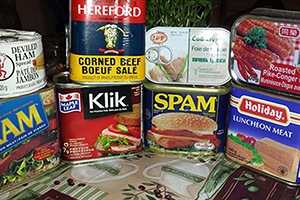 Meat and meat-related canned products can arguably last the most time. Once you choose protein-rich canned meat products, you will be more equipped to handle emergencies.
Meat and meat-related canned products can arguably last the most time. Once you choose protein-rich canned meat products, you will be more equipped to handle emergencies.
You can get canned meat products to make sandwiches and other instant meals.
For instance, you can choose one of the best meat canned products in the market like Mary Kitchen Hash Mary Kitchen Corned Beef, HORMEL Canned Ham, Hormel Beef Tamales, and Spam Classic.
Related: How to Make Spam
Vegetables and Soups
After canned meat products, you can move on to the canned vegetable and canned soup products.
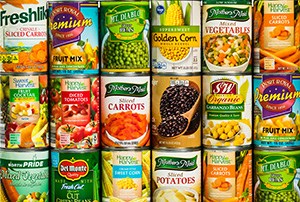 Contrary to misguided perception, canned vegetables are as nutritious and healthy as fresh vegetables.
Contrary to misguided perception, canned vegetables are as nutritious and healthy as fresh vegetables.
You can get Allen’s Popeye Spinach, Farmer’s Market Foods Canned Organic Pumpkin, Libby’s Sliced Carrots, Muir Glen, Organic Stewed Tomatoes, and Ortega Peppers.
Similarly, you can get canned soup products like Traditional Chicken and Wild Rice Soup, Campbell’s Chicken Noodle Soup, and Dinty Moore Beef Stew. These fresh and nutritious canned products come with vitamin A/B and can boost your carotenoid levels.
Poultry
No matter what you may have heard, the canning process doesn’t lose the freshness and healthy nutrients of poultry products. Whether you want canned products for short or long-term emergencies, you should think about purchasing canned turkey and chicken products.
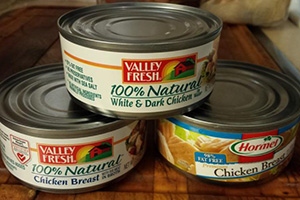 Besides, there are endless delicious, easy, and quick canned chicken recipes you can make at home. You can get canned poultry products such as Kirkland Signature Chicken Breast Swanson Premium White Chunk Chicken Breast, Valley Fresh Organic White Chicken, Spam Oven Roasted Turkey, and Keystone Meats All-Natural Canned Chicken.
Besides, there are endless delicious, easy, and quick canned chicken recipes you can make at home. You can get canned poultry products such as Kirkland Signature Chicken Breast Swanson Premium White Chunk Chicken Breast, Valley Fresh Organic White Chicken, Spam Oven Roasted Turkey, and Keystone Meats All-Natural Canned Chicken.
Related: The Ultimate Chicken Meat Processing Guide for Preppers
Bread
When an emergency knocks on your door, it becomes harder to get your hands on fresh bread.
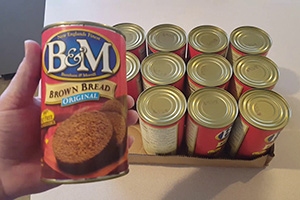
In fact, if the area you live in is about to go into total lockdown, you should stockpile bread in your pantry. Sure, the bread won’t remain as fresh as eggs or beans, but you can make different types of sandwiches. For starters, you can purchase B&M Bread Brown Raisin, B&M Bread Brown Original, and B&M Bread Brown Plain.
Butter
Right after you get the bread, you probably would want to purchase butter for emergencies. Not to mention most of the great cooking recipes and procedures require butter as an essential ingredient. Therefore, don’t hesitate to get canned butter for any emergency.
 Most canned butter products can last more than 3 years. You should look for canned butter products like Augason Farms Butter Powder.
Most canned butter products can last more than 3 years. You should look for canned butter products like Augason Farms Butter Powder.
On the other hand, you can also get nut butter canned products that pack more nutrients. With nut butter canned products, you can add monounsaturated fats into your daily diet. You can get products like Jif Creamy Peanut Butter into your remote routine that can last for years.
Fish
You can find many seafood canned foods on the market. In fact, you’d be surprised how many people prefer seafood over meat canned products. Realistically, canned fish products can stay fresher and healthier than other counterpart canned products.
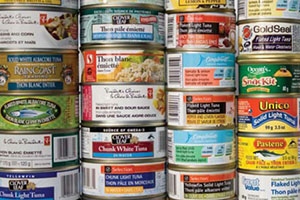 With canned fish products, you will receive omega-3 fatty acids and as well as proteins.
With canned fish products, you will receive omega-3 fatty acids and as well as proteins.
As you spend more time indoors during emergencies, it would be a smart choice to get canned fish products to maintain your cardiovascular health.
You can get canned fish products like StarKist Selects EVOO, Solid Yellowfin Tuna, Royal Pink Wild Alaska Pink Salmon, MW Polar Smoked Brisling Sardines, Cod Liver, Chicken of he Sea Solid White Albacore Tuna, and John West Kippers.
Cheese
If you want to make quick and delicious pasta dishes, you should get canned cheese. You may have heard the bad word of mouth about canned cheese, but it contains high nutrients and stay as fresh as natural cheese.

Many canned cheese products have a shelf life of at least 1 year.
You can get canned cheese products like Cheddar Cheese Powder, Augason Farms, and Freeze-Dried Shredded Colby Cheese.
Related: My First Batch Of Canned Cheese
Corn
Corn is another essential item you should have in your pantry during times of crisis. With canned corn products, you can enjoy off season corn. It is high time to include in your pantry some canned corn products. However, during the canning process, canned corn loses a small amount of vitamin C, but it’s negligible.
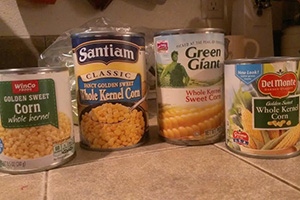
Canned corn products, however, have the same taste and nutrients as seasonal corn. You can purchase Copes Corn Sweet Dried, Reese Baby Corn, Libby’s Whole Kernel Sweet Corn, Native Forest Organic Cut Baby Corn, Kirkland Golden Sweet Corn, or Green Giant Whole Kernel Sweet Corn.
Beans
For most Americans, beans, lentils, and peas are the most important pantry items. In fact, you can make great recipes with affordable canned bean products.
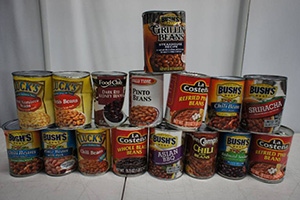
Apart from protein intake, you can get vitamins and iron with beans. Beans canned products can also lower cholesterol during your remote stay.
You can purchase canned beans like Cortas Fava Beans, Blue Runner Creole Cream Red Beans, BUSH’S BEST Baked Beans, S&W’s Organic Black Beans, Goya Black Beans, and Eden Organic Navy Beans.
If you feel like another lockdown or emergency is around the corner, the smart thing would be to purchase a variety of canned foods. The long shelf life of canned foods can help you stay remote for as long as a decade. For instance, canned food consists of all the vitamins, minerals, and protein you need to consume during emergencies.
In the age of diverse product categories, there are more than enough canned food options in the market. Often, people are overwhelmed by available canned food products. In any case, think of the canned foods as a blessing in disguise to stay remote, safe, and wait for the pandemic crisis to be over.
You may also like:
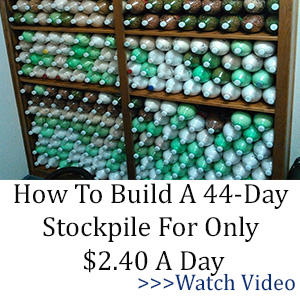 14 Must-Have Canned Foods You Didn’t Know Existed
14 Must-Have Canned Foods You Didn’t Know Existed
How Our Ancestors Survived Without Grocery Stores, Running Water and Power (Video)

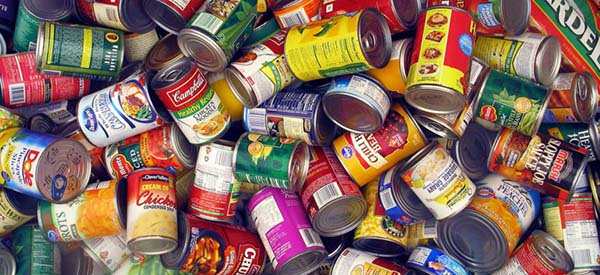













fruits >>> it’s another canned food category that’s a necessity …
in a severe SHTF some of the more exotic fruits like pineapple might disappear for the remainder of your life …
you could be out begging for something as common as an apple …..
(I haven’t read all the comments yet so this might already be mentioned…) As far as canned Pineapple or other high acid canned goods go to incl: tomato sauces and paste, Mandirin Oranges, Grapefruit pieces, etc will eventually eat through a can. (I know from experience), even in a climate controlled environment. These were about 10 year old cans so that may ‘splain it’. This is when FIFO or rotation is extremely important. Jus’sayin.
Keep your powder dry and God Bless America…PLEASE
some of the better brand name companies have gone to a white poly can liner vs the old traditional process line “varnish” – does a fair job of eliminating the acidic can “eat thru” ….
going to be mute in the near future – just like the can openers being elimnated by the pop tops >>> the metal cans are already being replaced by retort type poly packs – they’ll be hanging on hooks in your canned goods section – even your 6 pack beverages will be going packs instead …..
The website you want for WSU canned cheese is https://creamery.wsu.edu
Unfortunately, today the website is down as they are busy catching up on orders on hand. They advise to check back daily to find out when they are again shipping.
I suspect that inasmuch as it is just two weeks before Christmas that the Christmas break or whatever the socialistic centers of anarchy are calling the break they take at this time of year, is impacting student participation in commercialism. It is my estimation that they probably won’t begin shipments again until sometime after the winter solstice holiday. If you are an optimist, you might check back on Monday 14th.
For the rest of the old curmudgeons who follow this list, Contented Christmas and let us all beseech whomever we pray to for a better year in 2021.
With the PDRK proclaiming that families must isolate from other family members who are presently not in the household, it is really difficult to wish a Merry Christmas if we are really isolating from dear friends and family. While Goobinator Gabby Nuisance may not be enjoying Christmas Eve at the French Laundry, I have a suspicion Auntie Nan Pelosie and other political poobahs will be dropping by the Nuisance family estates over the holidays.
I just checked the website and they are not taking any orders till after Jan 1.
Ah, but will San Fran Nan be bringing ice cream for dessert?
Freeze dried and dehydrated foods should have been included in this article. They taste great and can be stored for 25 to 30 years as long as they are stored properly, especially temperature. These foods can be purchased in #10 size cans and pantry size cans. Our favorite vendors are Ready Store and Augason Farms. Any internet search will find these.
Over the Years, every few trips to the Mega-Lo-Mart I’ll purchase several bags of freeze-Dry meals by Mountain House. Between the old backpacking days in No. California and the LRRP rations I got in the Army (both of those events are in my rear view mirror…lol) I’ve been eating their food(s) for 45+ years. So over the course of those shopping trips, I’ve accumulated many dozens of meals. Not the most practical way of buying freeze-dry but it worked for me. I even have several in my GHB in my truck, I work 100 miles away from home so I have a pretty long commute which equals to a very long get-home, should the event(s) ever come.
Rob: Montague Bikes, a very old name in bicycling, is advertising that they have the paratrooper model back in stock. They have models from the basic at $700 to the super elite at about $2500 with about seven models in that line. I have looked at the paratrooper in the past and am Impressed with it. If bugging out by bicycle were still physically possible one of the paratrooper line most certainly would be under serious consideration.They all fold down to a nice, neat compact form that would fit in a trunk or behind the seat of a pick-up truck. They come with an under-the-rear-wheel bicycle stand which is ideal when one wants to load packs and such on the bike.
While a 100 mile in one day ride is physically possible for the in-shape bicyclist, 50 miles a day is far more doable even for the bicyclist who only cycles on weekends when there is a full moon. You will be stiff and sore and have blisters on your butt after two back-to-back 50 mile days but you will be home—assuming no major detours or setbacks along the way.
OTOH, going by shanks’ mare will take you 5 days if you are able to do 5 20-mile days in a row. If you are not accustomed to hiking 20 miles on successive days, you may not make it due to blistered feet.
Yeah, I know, we all hiked lots of miles when encouraged to do so by the platoon sergeant and the gung ho butter bar fresh out of Basic School, but how many years ago was that? I was in so long ago we were still smoking Lucky Strike greens in the C-rations.
For those who are wondering what Lucky Strike greens were, during WWII it was rumored that the chemicals in the red ink of the circle on the pack of Luckies were needed for war munitions and in order to show their patriotism, Lucky Strike printed the red circle in green ink, thus Lucky Strike greens.
Fortunately my bike riding days are less than twenty years ago — has it really been that long— and I got a lot of bicycling experience during those long distance days.
While physically I could easily do 100 miles of varied terrain, I never liked a 100 mile day because it meant that you had no time for side trips or watching interesting scenery. In order to do 100 miles in 5 hours one had to average 20 mph with zero stops. Even at 16 mph average non-stop it takes six hours and 15 minutes. That means you eat while riding and for guys they can manage to relieve themselves while riding but I don’t think that is fun.
While a 20 mph or 16 mph average or 5 or 6 or 8 hours may seem awfully slow when professional riders can average 30 mph the difference is except for the finish line sprint at the end of each day he has a team of domestique riders pulling draft for him most of the way. The domestique drops back and another one takes his place in the pull in order to maintain that high average and they do what I described above while hunched over on their bikes in a low drag mode. So professional bicycle riding has as much relevance to get home riding as a drive on a country road has to do with the Indy 500.
If you are trying to get home after the end of the world, you don’t want to be riding hell-bent-for-leather with your head in a tuck position. You want to be sitting up tall scanning in all directions for undesired attention of possibly unfriendly folks who may think they deserve to ride home more than you do.
Many types of canned foods can be purchased on-line and delivered to your home, in case you want to avoid contact with other people who may be carriers of Covid.
I agree about the canned fruit. How about pie filling? I have some of those as well. You might also consider some cans of milk products, at least for the short term. Things that I don’t grow or home can in jars, I purchase as canned goods, especially meats, fruits, cheese, and soups.
It will all be about balanced nutrition. Rice and beans will get old quick. Make sure to stock up on proteins like the author says. Canned Tuna and salmon will be fantastic as far as Omega 3’s are concerned. Washington State University in Pullman WA makes a canned cheese that is FANTASTIC. It needs to be refrigerated but can last up to 30 years in the fridge. Look at their website. They have several varieties as well. Red Feather butter is also a great addition. Yes it is a bit expensive but not as much so as freeze dried is. Plus you will not need water to reconstitute it.
I agree with Illini Warrior to get stuff like canned fruits for sure. As he says Pineapple may be gone forever. Banana’s may be gone forever as well. We have a ton of freeze dried banana’s and a ton of the Pineapple.
Look at spices as well all.
As I said please put away ingredients for balanced meals to the extent possible. Canned Hash is fantastic!!! Love the stuff.
Don’t forget seeds. when cans are gone how will you replace them????????
Merry Christmas all
Agree with every thing said. I also like to have a hundred pounds of rice on hand. you can create or stretch a lot of meals with rice.
Ok ramen
I have canned a big ham in pint jars, 1 1/2 18 lb turkyes and several quarts of meaty bone broth. I’ll be adding to that beside what I’ve purchase. Added a few cases of pineapple and mandarine oranges recently. Adding fruits, meats, vegetables as money allows. I have 50lb bags of food grade grains that will be cooked, ground, or planted as needed. Rolled rye 50lb. Feed some to fowels and cook some for us. Could make flour from it also. I have 25 year canned grains left from 2000. They were free, so have another 5 years, and just take up space.
So stuff rated for 25 years really does remain edible? I’ve always wondered about that.
Yes they do and there is a lot of evidence to support this. These companies have been in business for 30 or more years. They routinely open and try out their older cans to verify their shelf life. Research and Goggle/DuckDuckGo this. Call them. Purchase a few cans/buckets and try them after 5 or more years. There is a great variety of foods and the foods are quite good and tasty
Cool, thanks.
IvyMike
The wife and I have eaten several of our now 8 YO freeze dried foods. They are still great. Most of our stuff has been by Thrive Life, we have other brands mixed but that is the bulk of that vintage and so far so good. I am checking out JohnC’s suggested website to see what it has to say as well. Never hurts to learn something new!
Buy wheat and a hand mill to make flour. Then you can bake fresh bread. Plant fruit trees that produce reliably in your area. You know food emergencies are coming sooner or later. Buy canned food for Sooner and plant fruit trees for Later.
To IvyMike, I was given 44 cases of ‘SamAndy” #10 cans that were packaged in 1975. The rice was good and the dehydrated fruit was great, the dehydrated figs I still use with the oatmeal. The soy based meat substitute was fed to the local geese and turkey flocks. This may be a testimony to the quality of the original ‘SamAndy’ product. 45 years old and edible. Don’t know about the loss of nutrient value. These products may have been grown ‘pre Roundup’ also. Blessings
Does anybody have any good websites for putting in a large root cellar? I live in an area very prone to wildfires and summer heat. My hubby has agreed to put in a root cellar the size of a bedroom. I need that much room for my supplies.I need to know how to mitigate water as we do get lots of winter rain. Thank you!
Sel, if you’re planning to do the work yourself, take a look here https://www.youtube.com/watch?v=m70ZAXm00k0 Then look at the related links on the youtube page. If you have the money to have it built, most contractors that build basements can build a root cellar. Good luck, keep us informed on your progress.
Older private homes here in the big city, builds in the early 1900s, have unheated underground rooms accessible from a walk-in door in the basement. These rooms are usually located under an open or inclosed unheated porch. Many people use these rooms which were originally intended to be used as root cellars, as
wine cellars. On a side note, it’s easy too to hide the entrance to them if you choose to do so. The city no longer has many of the older house plans on record.
I usually enjoy these articles but this one was ehh. I know what kinds of things are in cans and I don’t need a list of all the brands with each category. That’s about all this was.
Every article is a winner for some and a loser for others. It is the exchange of information among the followers of the list where the real gems are found. For instance, in this article I found Consco’s advice about where to buy canned cheese (other than Cheese Whiz which is not really cheese but some chemical compound reputed to have a 5,000 year shelf life) a tidbit of information that made reading the article and the comments worth while.
I am just amazed at the amount of food that clergy lady has put up and with a badly broken wrist too! She’s a lot tougher than I. And far more skilled in the preppier life style than I. I wish she were my neighbor. I would feel a lot more secure about the end of the world. She is a walking, talking prepper manual. If she doesn’t know how to do it, it probably isn’t important enough to bother with.
LCC
Could not agree more about all you say here. You are a fountain of info. Others like Ivy Mike, Illini Warrior and yes ClergyLady to name a few would all be fantastic neighbors. Some of the articles do not hold much interest for me but the responses are what usually make up for that. I read a lot for a guy who still has to work 60 hours a week. 2 years or less until retirement and I will still read a lot. Constantly trying to increase my knowledge base and pass on tidbits to others in this community. That be what I have to trade in a survival scenario.
I wish I could put a thumb drive in ClergyLady’s head and download. I am 59 YO and am ashamed at the knowledge I lack on this topic compared to her. Hell I would park her on a chair for life and just let her give me instructions and it would be a bargain!
Keep up with sharing the info all I for one appreciate it greatly
This is the greatest time in history to be a reader, and to seek knowledge in general. The internet is endless and no question has one true answer, and just about every book ever written is available.
I retired at 62 to work for myself, was going to work until 70 but shut my business down to hide from The Covidia. Best thing I ever did. Everybody retire as soon as you can, if you get in money trouble you can go back to work, but life is great retired, except I’m busier now than ever trying to learn all the stuff Clergy Lady does every day.
I most heartedly second Mike suggestion. Don’t wait to retire. Yeah, waiting until the ultimate SS payout is a good idea, but retire without drawing SS is a better idea. Don’t wait for Medicare. Sign up for it as soon as you are eligible. While it sucks having big brother look over your shoulder for every bit of medical care you might want, they do save you big bucks because the are the 10,000 pound gorilla in the medical business and it doesn’t bother them a bit to beat up on a doctor who charges you $150 for a 90 second office visit or the hospital who charges you $5 for one aspirin.
I retired at 62 although I took in students from overseas who wanted to stay in an American home while they studied here in this country. I also did taxes for H&R Block but they wanted me to act like a used car salesman, adding extra charges without informing the customer. I didn’t do that, explaining what the extra charges were and how applicable I thought they were to each individual taxpayer. I am certainly not incorruptible, but my price tag for my integrity is a lot higher than a buck a piece. If you are not talking 10 figures to the left of the decimal don’t even open your mouth.
Did a stint at Target one Christmas and found out the military and large corporations waste a lot of manpower doing unless shit.
And my wife and I traveled. We didn’t have a lot of bucks, so mostly we car camped. We did a lot of long distance bike rides on our tandem until ill health issues hit me in my mid 70s. After I overcame them my wife had serious health problems so now in our 80s long distance travel is significantly curtailed. You will never be sorry that you retired sooner than later. You may always regret that you didn’t retire sooner than later. It’s not just your health that impacts what you do after retirement. Your spouse’s health also enters into the equation and you never know what pathological evil is going to creep into your lives to affect the life of both of you.
God Bless you for sharing your story ~ health challenges are the #1 life interference at any age.
Totally off topic, but for folks who were toying with the idea of a pcp air rifle for hunting and perhaps self-defense in a pinch but were put off by the prospect of hand pumping several hundred pumps to charge the beast or springing for a high pressure air pump to take up more space in the garage or constantly schlepping down to the local dive shop/paintball store, there is good news.
For only $700, Pyramid Air has a small pump that will go to 4500 psi. It runs on 110, 220 or 12 volt so if your car is handy, no thumbing through your iPhone for local dive shops if you are out in the North Woods hunting for bear with your .458 air rifle—or Wyoming, hunting for bison.
I have a pump up .22 which is ideal for small game. Might even go to a .25 pump up for coyotes and badgers. After the end of the world coyotes are going to get a major problem together with feral dogs. When the two of them join up and interbreed survivors of the EOTW will have a real problem with packs of dog coyotes.
As for black bear and bison, 180 grain 300 Win magnum or 200 or 220 grain .30-06 is more my preference. Those might even be fired in an M-1 Garand if you get the adjustable gas cylinder plug. A handy device to have if you have an M-1 that you are planning on using in an end of the world scenario.
Canned or preserved fish with the bones (sardines, canned bone in salmon, anchovies) are very good sources of calcium. Second only to your dairy products. Calcium deficiency will be very common after SHTF. Fight it with a stockpile of bony fish.
My family are big meat eaters. We cannot stand canned meat. Guess if we were without meat to long we’d learn to like it. We don’t buy what we don’t eat. I don’t eat MRE survival bucket food so we don’t buy that. It’s like a convenience store in our basement complete with store shelves. Our foods, tools & guns & cleaning supplies are organized on the shelves as well. Sales occur in cycles. All box jar & can goods are on sale once every 2 months. But these are cheapest in the Fall. Cereals cycle sales in a similar patern and are cheapest January & August. Many items only on sale once a year so stock up like turkey for Thanksgiving, ham for Christmas, Shrimp for New Year’s, corned beef fot St. Patrick’s, fish for Lent, lamb for Passover, hot dogs & ground beef for Memorial Independence & Labor. Invest in a chest freezer to take full advantage of sales. A stockpile is self assurance insurance. If you were out of work or whatever, your family will be fed.
Frozen is a great way to take advantage of sales, but if you were hit by a long term power outage and your generator ran out of gas or broke, you’d be in trouble.
Have you tried dehydrated or freeze dried meats? Some of them are supposed to be very good and don’t have the preservatives or high sodium of jerkies.
some of the better brand name companies have gone to a white poly can liner vs the old traditional process line “varnish” – does a fair job of eliminating the acidic can “eat thru” ….
going to be mute in the near future – just like the can openers being elimnated by the pop tops >>> the metal cans are already being replaced by retort type poly packs – they’ll be hanging on hooks in your canned goods section – even your 6 pack beverages will be going packs instead …..
Moot, actually. (Sorry, I’m a writer!) 🙂
Bill, I noticed the same word choice, but thought that a “mute” point may be one that doesn’t speak to anyone. Ha.
You will never convince me that anything in a can comes close to being as healthy as naturally grown fruits, vegetables, etc.
I don’t think there is any disagreement about this. But during emergencies there is no source for these. The available canned foods, and the dehydrated and freeze dried foods are really good substitutes.
Buy what you enjoy and what your family likes to eat. Incorporate canned foods into your recipes and regular meal plan. Stock up on these items when they are on sale and store them in a canned goods pantry. When you can not go out or the stores are empty, you can shop for diner in your own little store. Anything else, can be a waste of money. Switch to dry goods for long term storage.
We store what we normally eat in larger quantities and rotate through it with replacements. We also have hundreds of pounds of dried beans, potato flakes, a variety of grains, rice, and pastas beyond our normal usage. Keystone canned meats are excellent and not overly priced at Walmart. Keystone comes in pork cuts, beef cuts, ground beef, and chicken cuts. It’s all precooked, stored in its own broth, and can be used in many ways.
Been covered many times before. Buy what your family enjoys eating. If you don’t like English peas don’t stock up on them. Next.
I would suggest adding canned butter in the form of ghee. It can be found at any Indian food shop, online and in the “ethnic” section of larger supermarkets. Trader Joe’s has small jars with the cooking oils. It lasts a long time unopened, is shelf stable, doesn’t require refrigeration after opening and tastes better than oil in most recipes. It also is a good source of vitamin D and A.
Our local “world” market sells a pound of ghee for about ten bucks (for the cheapest). Three or four brands to choose from.
If you’re ever in Houston, look up a market called Phoenicia.
Which is a really good price, when you consider that if you were to make your own you would need to get the butter and spend a couple of hours to render it. I’m not sure how many pounds of butter you need to make a pound of ghee, but buying it already made I figure you’re ahead of the game just on fuel and labor.
With regard to bread, wouldn’t buying and storing flour be better for having bread when there’s none on the shelves? I looked at the B&M bread, and a 2-pack was $13!
Also, you mentioned canned vegetables, but not canned fruit? Peaches and pears? Oh my!
No weevils or wheat moths and already cooked. But it’s sweet – really more of a snack or side dish than for sandwiches. Otoh, it’s really good with cream cheese, butter or peanut butter. My grandmother used to serve it with baked beans… it’s good for sopping up the bean “gravy”.
Also remember the types of vegetables that can be grown without pollination. Most of your tubers and a lot of the leafy greens especially broccoli and cauliflower. The latter 2 you eat the flowers. Tubers such as potatoes, carrots, beets and the like you eat the roots. Leafy greens like lettuce, kale and others you actually eat the plant. Almost all of these can be grown indoors year round and grow best with a grow light. You need to get heirloom seeds if you can to start growing and leave one or 2 plants to harvest seeds from.
EOTW = most likely no electricity = no grow lights. In my opinion, a better way to grow stuff is outdoors and as naturally as possible using natural fertilizers (compost) and as little water (unless you live in a high rain area) as possible. Depending on growing stuff in your garage with grow lights or hydroponics that require controlled temperature and constant water flow seems to me to be setting yourself up for failure if the EOTW is due to electricity loss. Even in non-EOTW emergencies what is the first utility to bite the dust? The juice. Here in the PDRK, the power companies are shutting off the juice if there is just a high wind. I’ve lived in this misbegotten state for 61 years and this year is the first year we have gone full third world with power shutoffs because of high winds. I don’t know what happens to your hydroponics tanks when the power is off for 72 hours but it can’t help the plants. Growlights probably not so much damage but longer than 72 hours and I suspect the plants start to show signs of deterioration. End of the world, gobble them up quick before they turn to disgusting slush.
LCC, I have a built in grow room. My living room is 30 feet wide and the ceilings are over 20 feet high. The entire east wall is made up of glass windows from ceiling to floor. My wife grows orchids in there year round, she has some blooming right now. The snow just outside the windows adds a nice contrast. I place my oldest pepper plants in pots and place them in there to winter over. I also have four of my tobacco plants that needed just a little longer to mature the seeds potted and finishing up. I grow 9 varieties of herbs for my wife, they do well in that same room during the winter. I’m drawing up some plans for a green house outside. It will be built into a hill side in my yard with the bottom half of it below ground level.
We always keep some canned Chili with Beans around. It is a good balance of fat, carbs and high in protein and fiber. 550 calories per can for maybe $1.50 if you shop around. I don’t like the pop top lids though and don’t know how long those would remain sealed. Any body know the answer to that?
Varying answers regarding pop tops. Some posters have reported that the cans turned bad well before the use by date. My experience so far is that I have pop tops that are two years past use by date and still edible without killing me. At least I don’t think I am dead yet. I suspect like so many things it depends upon where and how you store them. If they are in your metal outdoor shed in Phoenix, they may not last the first summer. If on the other hand, you live a mile or so inland on the Pacific coast north of San Francisco, they may well last several years past their use by date even if stored in your garage due to the temps rarely going above 70°. My personal opinion, based on nothing scientific, is that what is more important than the average storage temp is avoiding wild swings in temps. To that end I try to store my food in insulated boxes or styrofoam ice chests (which, by the way are no longer going to be available for sale in the PDRK after January 1. We are saving the environment by not allowing the sale of styrofoam ice chests in the PDRK.) Fortunately for me, I have always saved the styrofoam packing chest whenever I ordered stuff that might deteriorate in shipping. So my kids will find the response to their querulous question, “Whatta ya saving that trash for?” I can now say, “To save the drive to Nevada or Arizona to buy them.”
Lacking a suitable styrofoam ice chest, try wrapping the food in multiple layers of newspaper. It acts as insulation and will ameliorate wide temperature swings. In addition, all those padded envelopes from Amazon will also act as insulation for food items. Line the inside of cardboard boxes with those padded envelopes to lessen temperature swings for stored food.
Hope that helps. My answer, Alex is: “What is: it depends.”
Recanning, store can goods. works if you do it right. Only if you do it right…
Out of the can in to the mason jars.
Not for every one only the hard core preppers that will eat anything to survive.
LCC: Here in the southern Arizona desert without electricity my concern for storing canned food is the temperature inside the house with no a/c. Mainly during the summer months. If I recall right the last time we went without a/c for a few days the house was around 90 degrees during the peak of the day.
If we can’t can it, we don’t want it, usually. We waterbath only. anything else can be easily dried in our area (south Arizona). We like cheese, but never too much as we have a problem digesting it. Still, your suggestions are great! niio
Any dried products, place in freezer for a week or two, to kill insects and their eggs. It’s not perfect, but nothing is. After this, use mylar bags or jars and seal. We like jars because this is a rural area and rodents are thick.
We buy butter and eggs in season and store them. Butter for more than a year. It can be frozen in the package with no problems. Eggs, use what preservation you like best. We also freeze some. If the shell cracks, it’s not a problem for us.
And, always have a good solar food dryer in case the power fails more than 3 days in a row. niio
having a variety of canned goods, and keeping them rotated, should be good for a few years, but also add in some dried/dehydrated goods, especially fruits, as well as some freeze-dried foods for long-term storage. For basic long-term storage foods in #10 cans with up to 30-year shelf life, powdered milk with a 20-year shelf life, 1-gallon 7mil mylar bags, and 300cc oxygen absorbers, you might want to check out the LDS online store:
https://store.churchofjesuschrist.org/CategoryDisplay?categoryId=3074457345616678849&catalogId=3074457345616676768&langId=-1&storeId=10151
dz: While I love that store, and yes, their prices are very reasonable, one thing we’re blessed with in the southwest is solar. You could do this yourself cheaper. Buy extra vegs and dehydrate. You can can them or add an oxy absorber. Whole grain and legumes can be stored in metal trash cans or drums. I got drums off a retired Air Force bro in Tucson; the barrels have seals and now are loaded with maize and beans, chia, dehydrated coconut flakes, cocoa and so on. One freezer is going to have raw dried meat in it. One steel bucket will soon be filled with bricks of lard (we buy a little extra which prevents nosy people). There are a few, very few alas, jugs of used and abused oil and fat in the storage place. But, there are bricks of wax for lamps (AKA jar with candles that melted in the heat LOL). Go solar!
red, please reread my first sentence, it covers canned, dried/dehydrated, and freeze dried, and I have on-hand stock of each type. The LDS store is just one of many sources I use and prefer to have lots of options at my disposal. If you choose to do all your food preservation yourself, then by all means go for it, but it is not practical for me to attempt the same. We have different lifestyles and priorities, and I think you are confusing my attempts to learn to propagate plants and how to grow food as an attempt to be self-sufficient, which I cannot do at my current location or with the limited time I can allot to it.
dz: I’m beat up and sagging. I was on my feet so much yesterday they turned black. If I seem impatient, my apology. But, I understand what you said because of what you wrote. That’s my profession, manuscript research.
As a prepper, I had assumed you were going to farm markets and farmers to buy supplies. Most of us do and kali is known for her markets. In the grocery store, if I find a sale on sweet corn or veggies and fruit, I buy all I can. The least expensive way to add to your stores is do it yourself, not pay thru the nose for someone else’s products. A solar dryer can be made of scrap wood and pipes, and fly screen. I picked up a lot of strawberries on sale and most will be frozen. For that matter, fresh was 2/3 the price of already frozen. 10# cans are not always less expensive than the same per pound price of smaller cans. Dinged cans should be opened and the contents frozen or dehydrated. OK? You’re an agronomist and good at it. BTW, https://nativeplantandseed.com/ up near Flagstaff, AZ, has Indian Rice Grass seed by the pound, vervain and other herbal seeds. Rice grass is becoming a commercial grain that is a perennial and gowes best without irrigation. niio
red, for me everything is either on the “to do” list, or I’m already trying it, such as solar. I ordered a couple of the hanging type mesh drying bags, but the vendor cancelled the order because they are out of stock, so will look elsewhere. I don’t mind trying to make things myself, but it is a matter of time management because I work full time, and also have medical conditions for myself and other family members to deal with.
did you notice for the LDS store I specifically pointed out they carry 1-gallon 7mil mylar bags and 300cc oxygen absorbers. They also have sealers that look heavy duty but cost much more than mass produced versions like Food-Savers.
there are a few farms and farmers markets around, but most are far from my house and not worth the drive, so we get the majority of our fresh produce from stores, although we do watch for the roadside fruit vendors that sometimes set up nearby.
since my 25’x30′ front yard is an unused gopher infested patch of old topsoil that grows weeds really well after the few times it rains, I’ll have to research but wonder what would happen if I planted rice grass and/or winter wheat over the whole thing. I tried amaranth in the front yard last year but as Sage mentioned, maybe the birds (and maybe harvester ants) ate all the seeds, so it did not reseed and come back on its own at all anywhere.
dz: Are you getting enough rest? Do not let anything get you down.
Farmers usually have a web site and you can get notices when they’ll be around. I refuse t blow the wad driving down to Tucson every Sunday to the farm market. The man who comes to Catalina (25 miles from here) lets us know when and how much ammo he found to sell.
Yeah, I checked the site and while I’m not into mylar and so on, it’s a good site. I passed the addy on. I’m trying to find that freekin addy for a list of growers. It goes by state and county. niio